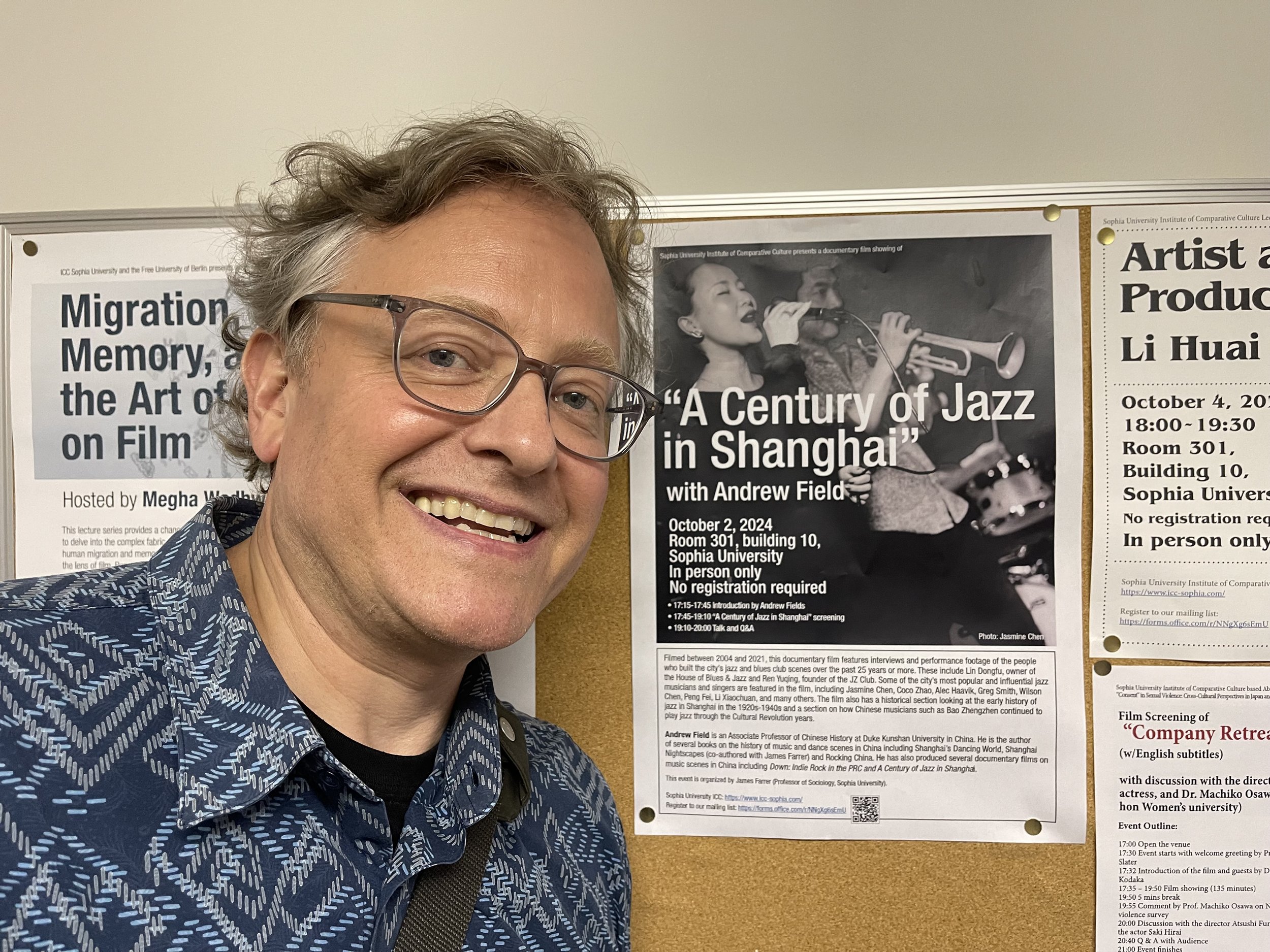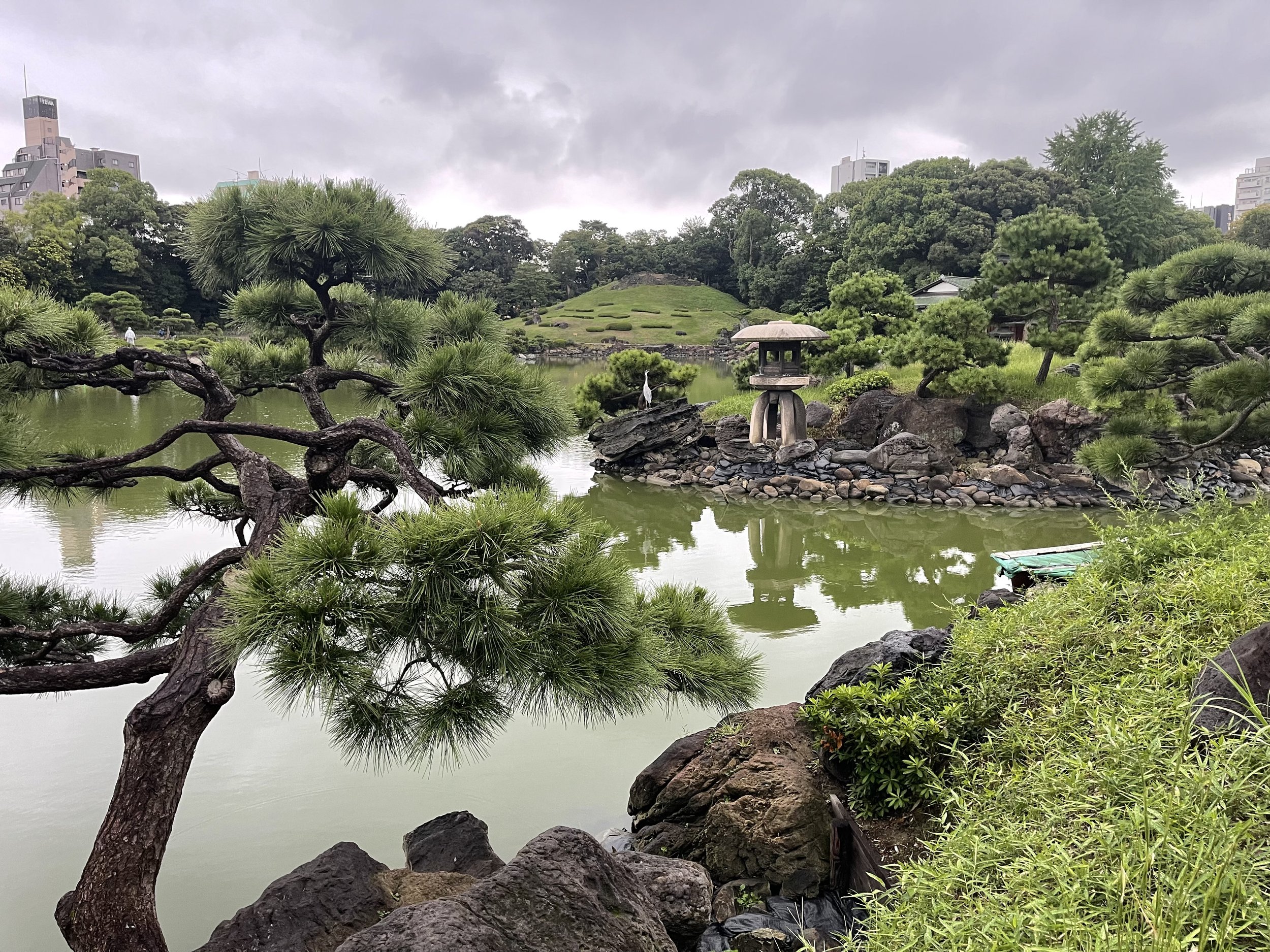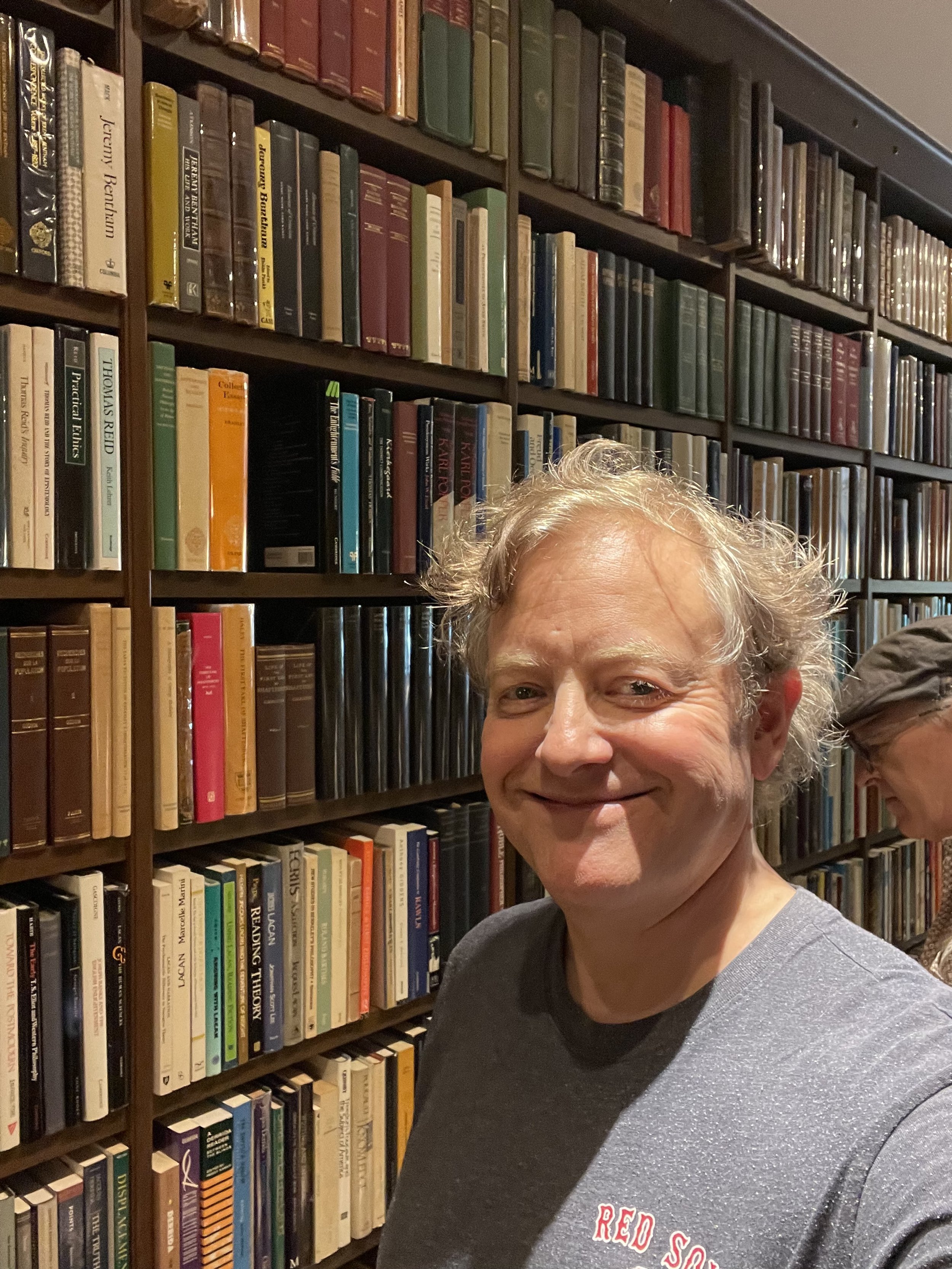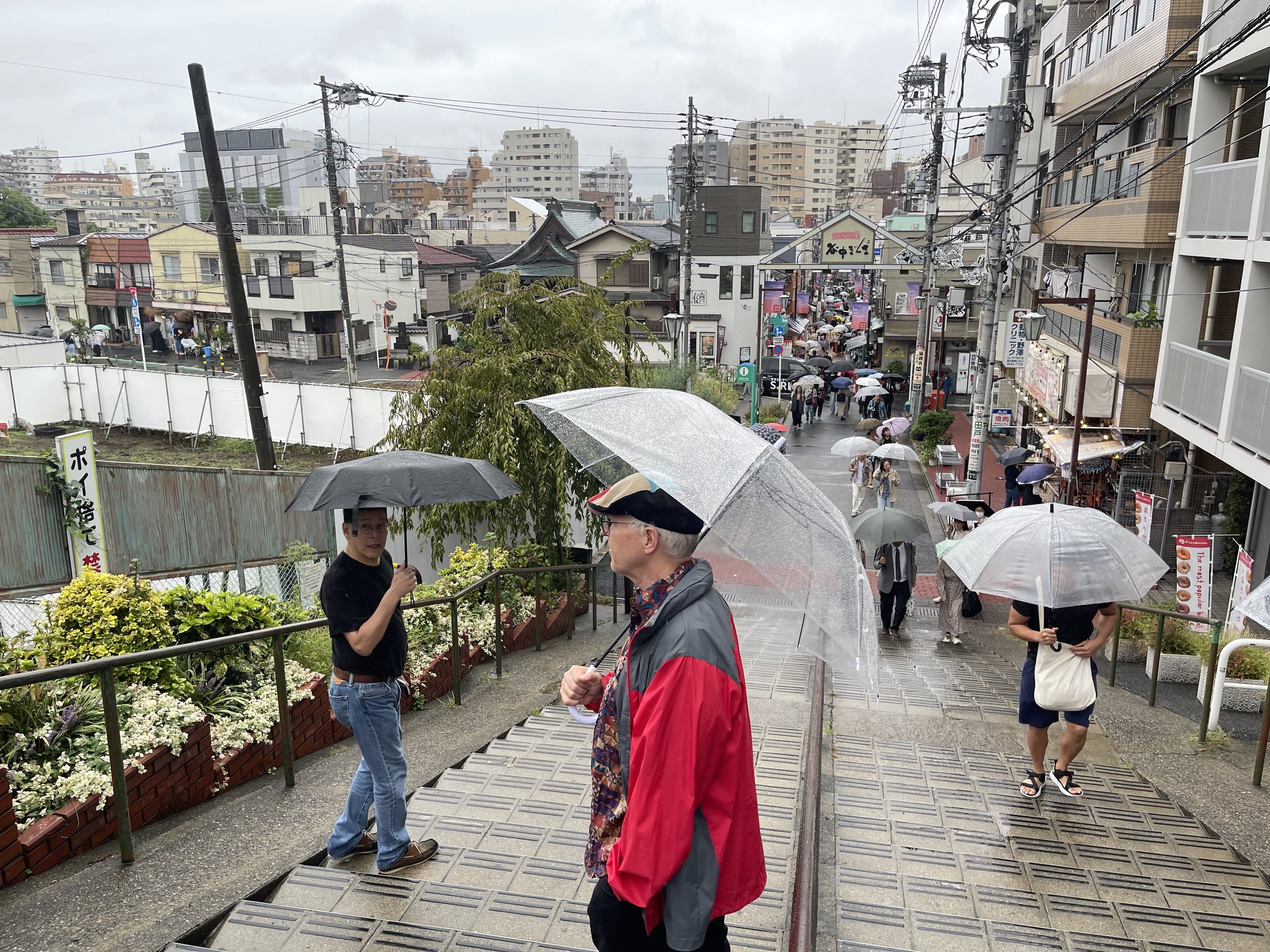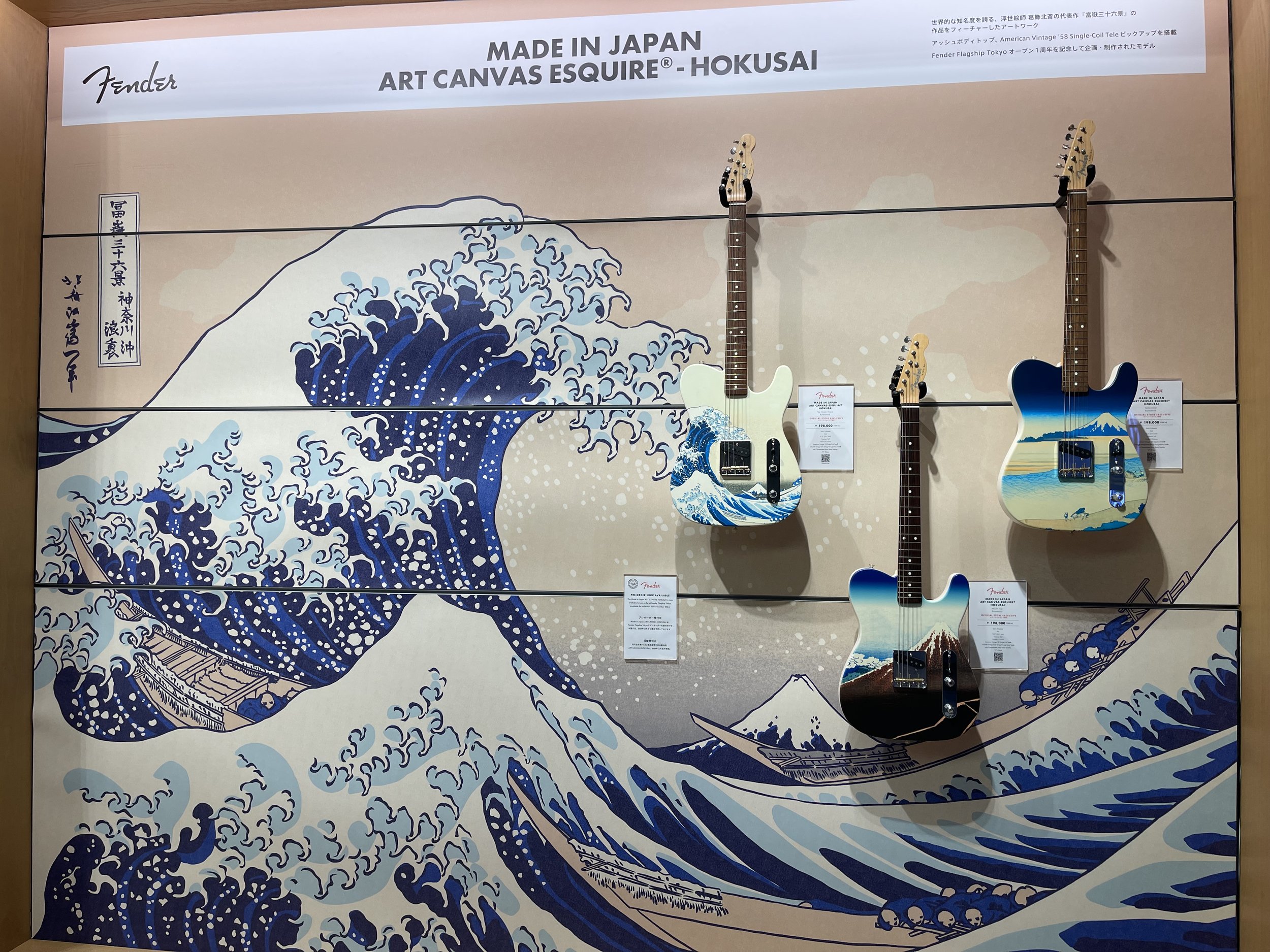Last week was the Chinese national holiday. I decided to take advantage of our week-long break from teaching and go pay a visit to my old friend and Shanghai Nightscapes co-author Dr. James Farrer, whom I hadn’t seen in person since the pandemic started in January 2020. I also hadn’t been back to Tokyo since 2018 and was long overdue for a visit. James has been living in Tokyo for nearly 25 years now, which is as long or longer than my sojourn in Shanghai. Over the years he has morphed from a China-focused sociologist to a Japan-focused one. At the same time, he has moved from researching sexuality (his first book Opening Up explores youth sexuality in 1990s Shanghai) to nightlife (our book) to food studies (his latest book is The Global Japanese Restaurant). His next big book project will be on the life of a neighborhood in Tokyo—his neighborhood of Nishi-ogikubo—and it promises to integrate all his research interests together into a fine package.
James teaches sociology at Sophia University, a Jesuit university located in Yotsuya in the middle of Tokyo. I’ve been there many times over the years, have given many talks and screened my films there before. This time I had the opportunity to screen my latest film “A Century of Jazz in Shanghai” and to give a talk about the jazz scene in Shanghai. I also took many walks around different neighborhoods of Tokyo, mostly with James, and I saw a concert of Japanese jazz artists on my final night. Throughout my brief sojourn there, I sampled many different varieties of Japanese cuisine, witnessed a religious ritual in a Buddhist temple, and worshipped guitars at a Fender flagship store. Here are some of the highlights of my three-day trip to Tokyo.
I arrived on Wednesday, October 2, and made my way from Haneda Airport by trains to Yotsuya. At Haneda, I purchased a Suica, a plastic card that proved quite handy throughout my trip. I highly recommend that visitors to the city get this card at the airport, since you can use it to swipe the train entrances and exits and pay for your fare instead of buying tickets each time. You can also use it in convenience stores and in the ubiquitous vending machines that are everywhere and sell nearly everything (drinks in particular).
James gave me instructions on how best to get to Yotsuya: “There are multiple ways to get from Haneda to Sophia. The best, I think, is to take the Monorail from Haneda to Hammatsucho 浜松町. Then take the Yamanote Line to Kanda 神田駅, and from Kanda take the Chuo Line to Yotsuya 四ツ谷駅. So you change trains twice, but the distance you travel within the stations is quite short. Sophia 上智大学 is right in front of the station.” I followed these instructions to the letter and it took around 1:20 to get there.
On the campus of Sophia University getting ready for my screening
I met James at his office and we walked around campus for a while and met a colleague or two before setting up for the screening and the talk. The talk was attended by a dozen or more people, not a big crowd but certainly a captive audience for the film. Afterwards, the audience members asked many excellent questions about the film and about the jazz scene in Shanghai. Then James took me and two other colleagues to dinner at a nearby yakitori (bbq chicken) restaurant in an alley across from Yotsuya station. After dinner, we headed to his home in the neighborhood of Nishi-ogikubo, located to the west of Yotsuya and Shinjuku, one of the main stations and central areas of Tokyo.
a post-talk dinner at an Edo-style yakitori restaurant in Yotsuya
James and his wife Gracia live in a modest yet cozy home in a low-rise neighborhood. It’s around a twenty-minute walk to and from the station. I found it hard to recognize the streets and alleys leading to their home, since they all seem to look alike as do the houses, and James told me he got lost the first few times after they moved there, but obviously he knows it like the back of his hand now. He and Gracia walk to and from their home to the station every day. Once on the train it takes James around fifteen minutes to get to his uni from that neighborhood, and for Gracia who teaches at Waseda, it’s about the same. So maybe a 45-minute commute from home to school.
One thing about Tokyo is that taking the trains is an essential part of city life. In Shanghai I’m quite spoiled—I usually drive my own car or else take a didi (hired cab) to get places. Seldom do I use the metro, although it is quite well developed in Shanghai now. I can even get from Shanghai to my home in Kunshan on the metro now. But I find driving from point A to point B a lot more comfortable and convenient, even though in Shanghai I have to drive through the usual mess of urban traffic to do so.
In Tokyo, fewer people own cars and most people use the train and subway system to get where they are going. For over twenty years I’ve been going to Tokyo for occasional visits, and each time I have to relearn the system of JR lines (the overground lines) and subway lines, which are all connected. I also need to relearn the names and locations of the neighborhoods that compose the city. It must be quite bewildering to foreign visitors who don’t know the language. I’m fortunate in that I know Chinese and can recognize the kanji (characters) and I also took a few years of Japanese language in grad school, so I have little trouble remembering the place names, and could ask for directions if necessary. But I must confess, and this is an ongoing theme of all my visits to Japan, that my language skills aren’t nearly as well developed as I’d like them to be. While I have a pretty solid foundation, I find myself struggling to understand people when they speak at a normal pace, let alone respond in a proper way.
The following day, my first full day in Tokyo, James left early for work, and I accompanied Gracia to the station via their usual pathways. I met James in Yotsuya Station at noon, and we headed to another neighborhood where he was giving a tour to some students. This was the Fukagawa neighborhood, which is east of the Sumida River (sumidagawa), a main river running through Tokyo. This was once a working class neighborhood where commoners who served the needs of the elite samurai and daimyo society of the Tokugawa era lived. It was also a temple district.
The Fukagawa Inn where we had lunch
We had lunch at a special restaurant that serves old Edo style food, the kind of food the locals used to eat back in the old days. We enjoyed a lunch of rice cooked with clams (a fisherman’s meal), and another rice dish that if I recall correctly was a carpenter’s meal.
The carpenter’s and fisherman’s meal
Afterwards we hung out in a trendy little café on the third floor of a building along with some young Japanese hipsters. At three pm, we met the students at the Fukagawa Edo Museum. There we explored the life of this old part of the city during the Tokugawa era. The museum provides a reproduction of an old Edo neighborhood replete with stories about the shop and home owners who occupied that neighborhood a few hundred years ago. The highlight of our visit to the museum was joining an 84-year old Japanese guide as he passionately explained the different ways that people ate and drank, celebrated the moon festival, and fought fires. There’s an impressive fire tower in the exhibit and the windows of the tower point in all directions except for the Shogun’s palace. I love exhibitions that bring history to life, and this one was enchanting—there was even a cat on the roof of one home that howled every now and then.
an 84 year old guide tells us about the fire tower behind him while we enjoy Edo-style tea
After visiting the museum, we went to a nearby park, Kiyosumi Gardens 清澄庭园 with a pond and gardens dating back to the Tokugawa era. These gardens dating back centuries provide a welcome interlude to the hustle and bustle of Tokyo.
Then we walked along a canal pathway while communing with the great poet Basho who once lived in this historic neighborhood. James took us to a Tantric Buddhist temple, where we experienced a full-on ceremony led by the monks and priests of the temple that included chanting and singing, drums and bells, and blessing objects in a ritual fire. The ceremony lasted around 30 minutes and was a deep dive into local Buddhist culture. Other audience members lined up for the monks to bless their bags and belongings by waving them over the ritual fire. I suppose I should have done the same.
inside the temple (we weren’t supposed to photograph the ritual so I didn’t, but I do have an audio recording of it)
After James’s tour ended, we parted ways with the students and got on the train, hoping to make it to another academic talk at Sophia, but we found ourselves running late and starving, so we bagged the talk and instead went to a canalside restaurant to have dinner. After that, we wandered through Shinjuku, checking out the various nightlife districts that make up this district, including the famous Kabukicho and Golden Gai areas. We found both to be full of curious foreign tourists from countries all over the world. According to James, the nighttime establishments of these famous nightlife districts, once closed off to most foreigners, are now eager to seek the foreign tourist business, especially in light of the pandemic which put a huge dent in the mizu shobai or “water trade” of Tokyo.
at an English language bookshop in Jimbocho
The following day, after enjoying a curry rice lunch at a neighborhood restaurant with a Michelin rating, James brought me to the area of Jimbocho, where we cruised the numerous bookshops that line the streets and alleys of this neighborhood. I was quite amazed at the quality of the second-hand English language bookshops, which carry beautiful hardbound and weighty books in the fields of literature, history, and philosophy. There are also countless Japanese bookshops that specialize in different types of literature, and huge collections of ephemera such as old magazines, maps and other materials. You could spend days exploring this neighborhood, especially if you are a bibliophile like me. Later I met another friend named Jeff who was in town for a visit, and we cruised up and down the “guitar street” of neighboring Ochanomizu, a locality named for the high quality of the water (mizu) which was ideal for making tea (ocha) for the shogun or emperor. This street features numerous guitar shops selling new and used electric and acoustic guitars, causing any guitarist to drool at all the models displayed on the walls and windows.
After our window-shopping expedition, Jeff and I joined James back in his own neighborhood of Nishi-ogikubo, where he has become a local celebrity for his knowledge of the shops, businesses, restaurants, cafes, and bars and the people who run and frequent them. For many years, James has run a blog focusing on his neighborhood, and recently he hosted a TV show for NHK World where he took a tour of the hood. James took us on a brief walking tour of the neighborhood around the train station, which goes back a century and half to when the area was farms and fields, and has developed rapidly and urbanized to become a part of Tokyo since the 1920s. We then had dinner at a local restaurant that specializes in mackerel, and James took us on a tour of the warren of alleys that surround the station, full of little bars and eateries. We settled in a bar run by a Chinese migrant from Suzhou, who was very friendly and knows James well, and hung out with some Japanese customers (it was mostly a male crowd). Then we headed down the alley to a tiny sunaku bar where James is also familiar with the owners, and we sang karaoke songs for a while. I got to relive my old days in Sapporo and sing a few Japanese enka folk tunes that I still astonishingly remember after all these years. I was pleased to find that the old karaoke bar culture of Japan still thrives in these little neighborhoods.
James showing off his Nihongo with a Japanese song
The following day was my last full day in Tokyo. After getting some rest in the morning, James and I headed out to meet Jeff at another neighborhood in the northern part of the city not far from Ueno. We took the trains to Nippori station, met Jeff there, and then walked over to the area known as Yanaka Ginza, a quaint area lined with shops, bars, and restaurants with an old Edo feel to it. We walked around in a light drizzle as people held umbrellas over their heads. Again there was a surprising number of foreign tourists in the neighborhood. In addition to shops and restaurants, there are also many temples and graveyards in the area. Graveyards in urban Japan are next to temples, unlike in China where graveyards are placed deep in the countryside away from people.
Entering Yanaka Ginza
After walking around the neighborhood and enjoying a leisurely cup of coffee in an old kisaten run by an elderly Japanese woman, we headed by train to Harajuku, where Jeff and I walked through the trendy cosplay neighborhood to the Fender Flagship Store and oggled the expensive and flashy guitars that lined the walls of the four-floor establishment.
A display at the entrance to the Fender Flagship Store in Harajuku
We then went to Shinjuku where we had a light dinner at an Oden restaurant. Oden are boiled snacks like tofu, daikon or radish, and other treats in a clear broth—they are popular in Chinese convenience stores as well.
After dinner we found the Pit Inn, an underground jazz club in the nichome district of Shinjuku. My old friend and fellow Dartmouth alum Cliff, who has lived in Japan a few years longer than James, had reserved seats for us. He was running late, and so we settled in the club along with others called in by the managers to sit in rows of seats in front of the stage. Eventually the band came out and started playing. Cliff arrived a bit later and so did James.
The band was the Setagawa Trio, composed of a pianist, a bass player, and a drummer. They have been playing together for nine years and have cut two albums. Their latest album called Progress came out in 2023.
The three musicians, all thirty-something Japanese men, played two sets. They’d clearly been playing together many years and had a fine onstage rapport with each other and with the crowd. I thought the bass player was the show-stealer. He was a large framed man with a funky hat and a beard who played a huge upright bass with tremendous joy and passion. At one point he even broke a string and had to replace it onstage while the piano player filled in with a jaunty piece.
The trio was obviously grounded in classic jazz, but they had an experimental side to them and they obviously enjoyed pushing the envelope with their music. I heard a few standards such as “Stella by Starlight”, “Li’l Darling”, “Make Someone Happy” and at the end of the concert, for an encore they performed their own version of John Lennon’s “Imagine”. They also played a few original compositions. All in all it was very high level playing that could have been heard in the best jazz clubs of any world class city. The experience made me wonder if I ought to make a film about Japanese jazz someday.
After the concert ended around 10 pm, we went our separate ways and James and I wended our way in the rain through the gay quarter of Shinjuku, which once again was full of foreigners, before heading back to the station to take the train to his neighborhood and walk back to his home.
The next day I caught my flight back to Shanghai, taking the trains to Haneda Airport from James’s neighborhood. It was a smooth journey, and I felt fairly comfortable riding the trains. I am certain that if I spent a few months in Japan, my language skills would be greatly solidified, but alas, that hasn’t happened in all the years since I first lived in Sapporo in the summer of 1993. But that is a story for another occasion.
I’ve always been impressed with how well Japanese society seems to integrate traditional cultures with modern everyday life and this trip offered many opportunities to experience that integration firsthand, especially when it comes to food and religion. On the other hand, Tokyo is such a frenetic society. People are always on the move, and the quintessential Tokyo experience is getting caught up in the mad rush of commuters in enormous stations like Shinjuku. People also seem perrenially tired, and I see a lot of snoozers on the trains.
The other impression I’m always left with when I visit is what I call the otakuness of Japanese society. Otaku means someone who delves deeply into a small subcultural phenomenon, and I may be misusing the term, but I apply to all the cases where people are obsessed with some particular taste culture, whether it’s collecting old rock and roll magazines or running a restaurant that specializes in mackerel or a bar that only serves genuine bourbon from the Deep South (of the USA). With everyone lining up for seats and then sitting there quietly (except when applauding) throughout the entire performance, even the jazz club had an otakuness to it that Shanghai clubs don’t seem to have. That tendency to delve deeply into one very specific pursuit or cultural interest seems to be very characteristic of Japanese society, which is one of the many things that makes Tokyo an endlessly fascinating city to explore.

